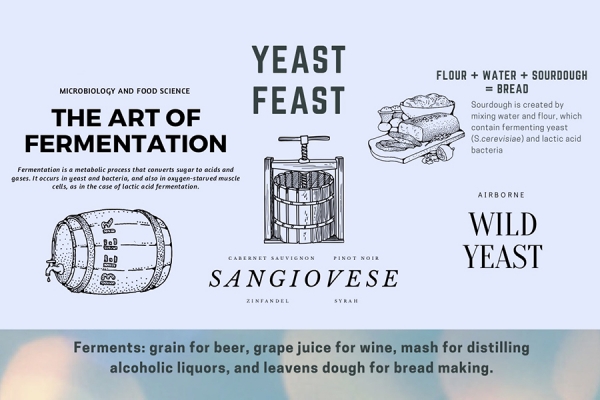 Student Shannon Smith designed a poster highlighting the genetics, habitats, and health impacts of yeast, along with — in the section shown — its culinary uses.
Student Shannon Smith designed a poster highlighting the genetics, habitats, and health impacts of yeast, along with — in the section shown — its culinary uses.
Undergraduates were encouraged to let their artistic-sides flow for a class project that turned microbiology knowledge into works of art.
Terri Lawrence, instructor of the second-year course “Introductory Microbiology,” asked students to create posters or infographics featuring micro-organisms in real-world situations.
“Asking them to create these infographics and getting them to use what they had learned in the course deepens their understanding of the information,” says Dr. Lawrence.
She says her teaching assistant, fourth-year student Lucas Vajko Siddall, thought up the project and directed the students into translating their knowledge. Vajko Siddall says he assigned all types of microbes — from fungi to prions — to the students and let them create what they wanted.
“It just had to be a real-world application, from the environment, to health care or even how people use microbes in cooking,” he says. “hey simply had to show how it applies to society.”
Undergraduate Shannon Smith took the course and created a poster about Saccharomyces Cerevisiae, or common yeast, and the art of fermentation and contributions to pharmaceuticals.
“It was a gratifying project this semester and a very welcome distraction from the COVID-19 world that we find ourselves immersed in daily,” says Smith.
“Combining scientific research into an infographic for the ultimate purpose of educating others about the microbial world in many ways enhanced my own understanding and provided a much-needed creative outlet.”
After the course was over, the infographics were donated to the Faculty of Science’s Science Meets Art (SMArt) group, which offers science students an opportunity to create science art and use that art for public education and science outreach.
“Donating their infographics made the students aware of SMArt and some of them are now planning on joining the group to keep making science art,” says Vajko Siddall. “This past year of the pandemic there has been little opportunity for clubs to attract and engage students, so this turned into another great opportunity.”
Biomedical sciences professor and SMArt faculty supervisor Dora Cavallo-Medved says it is not always easy to bring creativity into the classroom, especially with remote learning, but this class met the challenge and created something very useful.
“This is about connecting in class learning with the outside world — and using art as the medium to communicate science helps them focus and understand in a more creative way,” says Dr. Cavallo-Medved.
“We will use these infographics in SMArt’s science education outreach activities, showcase them on social media and use them in collaboration with after school science-art programs; they’ll be invaluable.”
Lawrence says the art project was a great success and she will use the activity again.
“I have truly enjoyed teaching online because it allowed me to get creative and it was invigorating for them, too, because it wasn’t just a multiple-choice test about abstract proteins,” she says. “This was unique and fun way to learn.”
—Sara Elliott